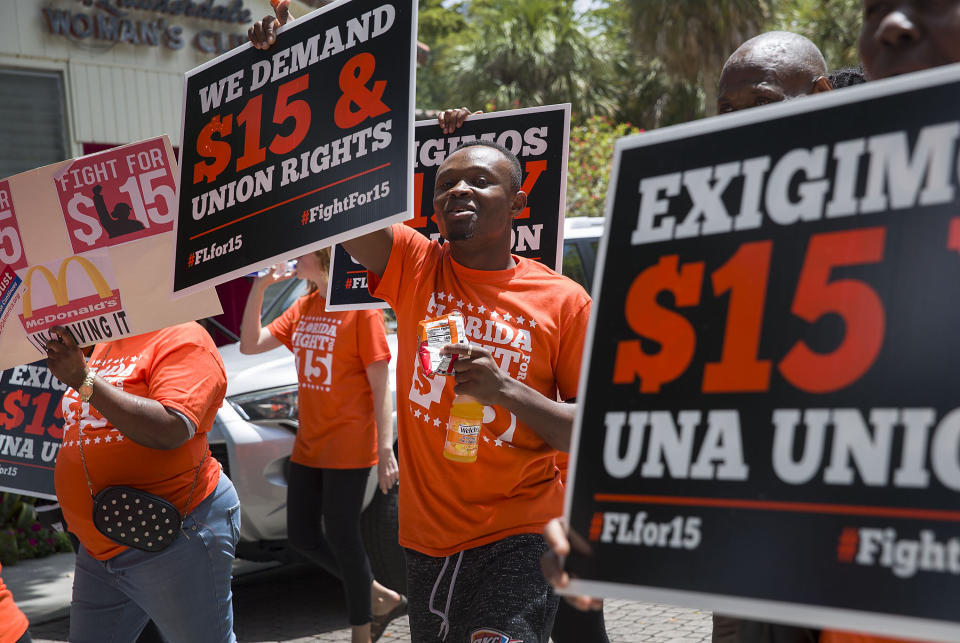CBO Says $15 Minimum Wage Would Hike Pay For 17 Million, Eliminate 1.3 Million Jobs
The Congressional Budget Office released a highly anticipated analysis Monday projecting the effects of a $15 federal minimum wage, finding it would raise pay for 17 million workers but leave 1.3 million fewer jobs.
The report from the nonpartisan research arm of Congress will give fodder to both conservatives and liberals in the debate over hiking the minimum wage. Democrats are now pushing a bill that, over the course of several years, would raise the federal minimum wage to $15 per hour, while Republicans have successfully blocked any effort to increase it from its current level of $7.25 over the past decade.
Republicans are pouncing on the CBO’s predicted cutbacks by employers, saying the hike would eat into job gains made during the long economic expansion. “That is unacceptable — one job lost is one too many,” said Rep. Virginia Foxx (N.C.), ranking Republican on the House Committee on Education and Labor.
But the CBO’s analysis projected that many workers would come out ahead, thanks to higher hourly pay offsetting cuts to hours. Rep. Bobby Scott (Va.), the Democrat taking the lead on the House’s $15 plan, said the report showed the benefits would be “widespread.”
“Overall, the CBO report comes to the clear conclusion that the benefits of gradually raising the minimum wage to $15 over five years far outweigh any potential costs to American workers,” Scott said on a call with reporters Monday.
The report also looked at the effects of hiking the minimum wage to $10 and $12, both of which had smaller repercussions. But the most politically significant analysis pertains to the $15 plan since it could soon come up for a vote in the Democratic-controlled House.
The CBO had a number of main takeaways on what roughly doubling the minimum wage over five years would mean for the economy:
―An estimated 17 million workers would see direct raises due to a $15 minimum wage, while several million more already earning above $15 might see increases as well.
―The wage increases would lead to higher prices as businesses pass along the additional labor costs to consumers.
―Total real family income would fall by about $9 billion ― or 0.9% ― by 2025 due to the employment cuts and higher prices.
CBO said that families above the poverty threshold would bear most of those costs, due to the loss in business income. But families currently below the poverty line would see the greatest benefit due to an additional $8 billion in real family income for that population in 2025. That would equate to an increase of more than 5% for that group.
The CBO cautioned that there’s really no way to know the results of a significant increase in the minimum wage since there’s “considerable uncertainty” about how such increases actually affect employment. The analysis found that there was a two-thirds probability that the job losses fall somewhere between zero and 3.7 million, with 1.3 million being the median.
Heidi Shierholz, an economist at the left-leaning Economic Policy Institute, said she felt the CBO’s methodology exaggerates the effects of any job losses. But even taking the CBO’s projections at face value, “The benefits to low-wage workers far exceed the costs,” Shierholz said.
As Shierholz noted, the CBO projected that the number of people below the poverty line would fall by more than a million due to the wage increase.

The federal minimum wage of $7.25 prevails in the 29 states that do not already mandate a higher one. It has not gone up since 2009, after the last of a series of increases signed into law by former President George W. Bush. Former President Barack Obama tried to raise the minimum wage ― first to $9 and later to $10.10 ― but was stymied by Republicans in Congress at all turns.
The current 10-year stretch without a raise is the longest the federal minimum wage has ever gone without an increase since it was implemented in 1938.
After pursuing more moderate increases for years, Democrats have gradually rallied around $15 as their number, buoyed by the labor-backed Fight for $15 campaign that won minimum wage hikes in cities and states around the country. Seven blue states are already on a trajectory toward $15: California, New York, Massachusetts, New Jersey, Illinois, Maryland and Connecticut.
Even many red states have increased their minimum wages in lieu of a federal hike, but the Democratic plan for $15 would bring more substantial raises and touch every corner of the country. The CBO did not break down the impact of a $15 federal minimum geographically.
Republicans and even some Democrats have argued that rural areas with lower costs of living could not withstand a significant increase to the wage floor over a few years. A small minority of Democrats have voiced support for an alternate minimum wage plan in which increases would vary from one locality to the next.
Even so, Democratic leaders are rallying around the $15 plan, which would make the minimum wage $15 everywhere by 2025, then tie it to an inflation index so that it rises with the cost of living. The bill could come up for a floor vote in the House as early as this month.
Love HuffPost? Become a founding member of HuffPost Plus today.
This article originally appeared on HuffPost.

